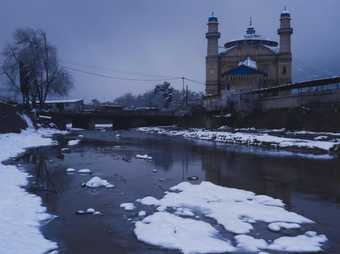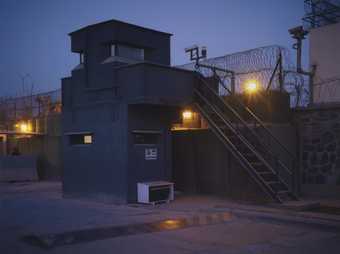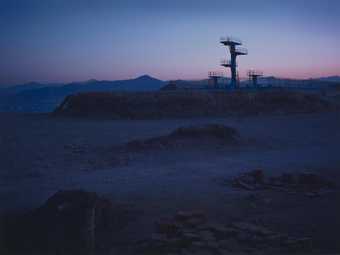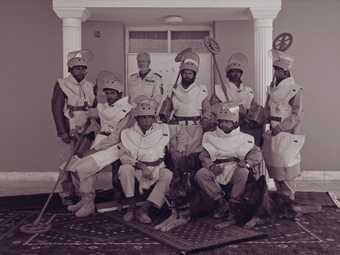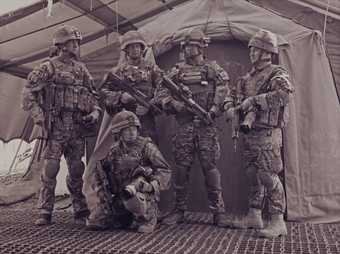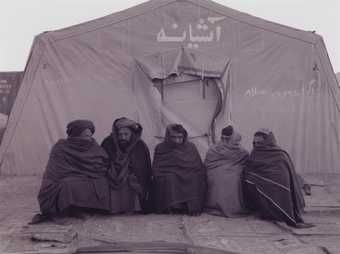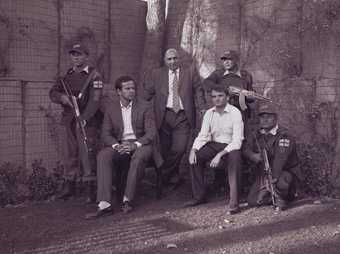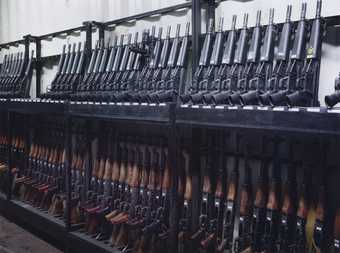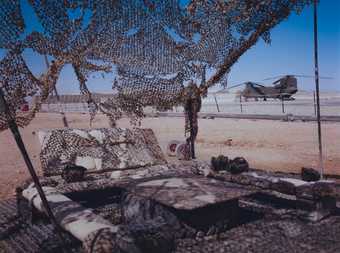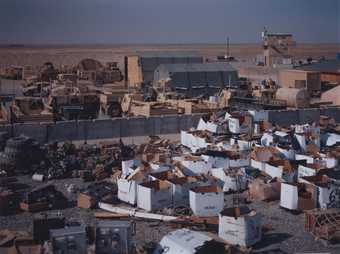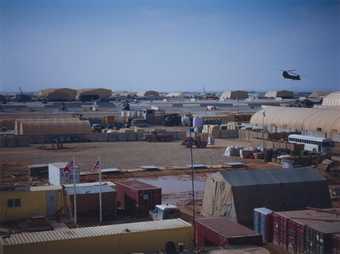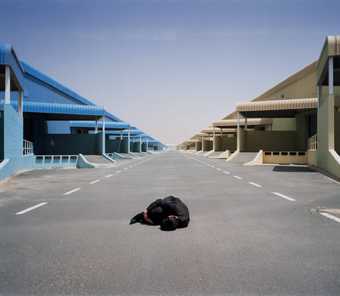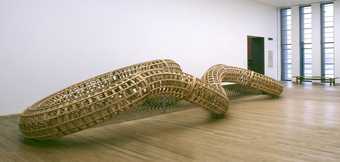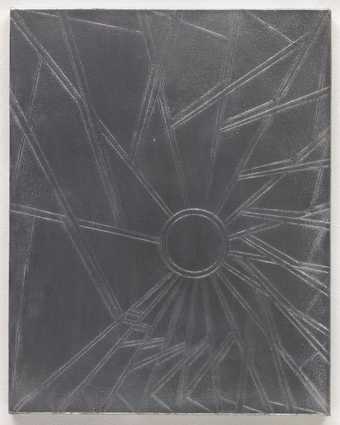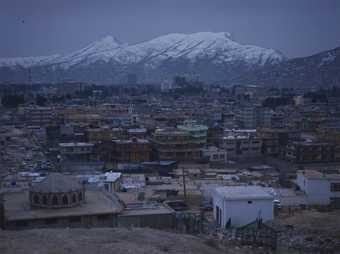
In Tate Liverpool
- Artist
- El Anatsui born 1944
- Medium
- Aluminium and copper
- Dimensions
- Unconfirmed: 2850 × 3730 mm
- Collection
- Tate
- Acquisition
- Purchased with funds provided by the Africa Acquisitions Committee 2015
- Reference
- T14331
Summary
Ink Splash II 2012 is a large wall piece in which Anatsui has connected several interwoven strips of flattened aluminium bottle tops using copper wire. This horizontal composition has a metallic shimmer dominated by a silver tonal palette in which blue and yellow splashes evoke gestural brushstrokes – presumably the ‘ink splashes’ of the title. The large blue areas lead the gaze from the upper left corner to the bottom right, pushing out smaller yellow splashes, which are spread out and almost blurred across the silvery surface. As if it were real paint escaping from a canvas, a blue patch of woven metal spills from the bottom of the work onto the gallery floor.
Anatsui first tried to escape the physical limits of the artwork in his series Bleeding Takari 2007 and Bleeding Takari II 2007 (Museum of Modern Art, New York). His earlier multi-strip wall pieces were closer to painting on canvas, being a sort of metal tapestry, while in the Bleeding Takari works he executed a shift that allowed the work to enter the sculptural realm. Ink Splash II 2012 forms part of a larger and experimental series which the artist initiated in 2009 with Ink Spill.
Speaking to Tate curator Elvira Dyangani Ose on 31 April 2012, the artist – who was born in Ghana but lives and works in Nigeria – mentioned that the titles of his earlier works misled many critics and art historians who occasionally reduced his works to a restricted canon of African art and its cultural context. This excluded other commentaries he considered crucial, including issues around gender and abstraction. The Ink works are evidence of his interest in pure abstraction, not necessarily mediated by ethnographic references to his culture of origin. In Ink Splash II, Anatsui uses processes such as the ‘sankofa’, an Akan word for ‘go back and pick’, in relation to looking back at the modus operandi of formalist abstract painters such as Sam Gilliam (born 1933) and Hans Hoffman (1880–1966). The art historian and curator Robert Storr has argued that like these western predecessors, Anatsui’s work ‘belongs to the history of modern abstraction but it can take its rightful place in that history only when the paradigms long relied on in discussing abstraction yield to the subtle, transformative pressure of Anatsui’s porous, pliant, scintillating fields of wonder.’ (Robert Storr, ‘The Shifting Shapes of Things to Come’, in Binder 2010, p.53.)
The practice of sankofa, art historian Chika Okeke-Agulu has stated, helps Anatsui to argue for a ‘critical examination of not just African history but also the consequences, in the post-colonial present, of its encounter with the West and the rest’. (Chika Okeke-Agulu, ‘Mark-Making and El Anatsui’s Reinvention of Sculpture’, in Binder 2010, p.36.) The materials Anatsui uses – copper wire and bottle tops – are part of that encounter and a reminder that the artist’s work involves change and regeneration. Moving away from common definitions of so-called recycled art or junk art, yet using objects found locally, Anatsui has found an aesthetic that attempts to speak directly to the experiences of individuals and communities immersed in that encounter. In his words:
The most important thing is the transformation. The fact that these media, each identifying a brand of drink, are no longer going back to serve the same role but are elements that could generate some reflection, some thinking, or just some wonder. This is possible because they are removed from their accustomed, functional context into a new one, and they bring along their histories and identities.
(Quoted in James 2008, p.53.)
Further reading
Laura Leffler James, ‘Convergence: History, Materials, and the Human Hand – An Interview with El Anatsui’, Art Journal, vol.67, no.2, 2008, pp.36–53.
Lisa Binder, El Anatsui: When I Last Wrote to You About Africa, exhibition catalogue, Museum for African Art, New York 2010.
Yukiya Kawaguchi and El Anatsui (eds.), A Fateful Journey: Africa in the Works of El Anatsui, exhibition catalogue, National Museum of Ethnology, Osaka 2010.
Elvira Dyangani Ose
August 2012
Does this text contain inaccurate information or language that you feel we should improve or change? We would like to hear from you.
Display caption
Ink Splash II resembles an abstract painting. However the illusion of swift, gestural brushstrokes and splashes has been created through a painstaking process of weaving flattened bottle tops together with copper wire. The artist explains, ‘the most important thing is the transformation. The fact that these media, each identifying a brand of drink, are no longer going back to serve the same role but are elements that could generate some reflection, some thinking, or just some wonder…[T]hey are removed from their accustomed, functional context into a new one, and they bring along their histories and identities.’
Gallery label, January 2016
Does this text contain inaccurate information or language that you feel we should improve or change? We would like to hear from you.
Explore
- emotions, concepts and ideas(16,416)
-
- formal qualities(12,454)
-
- weaving(13)
You might like
-
Simon Norfolk A shaded rest area built by helicoptor re-fuelling crews at Camp Bastion.
2011 -
Simon Norfolk The seemingly endless number of helicopter pads and hangars at Camp Bastion.
2011 -
Carey Young Body Techniques (after Sculpture II, Kirsten Justesen, 1969)
2007 -
Richard Deacon After
1998 -
Tomma Abts Dako
2016

